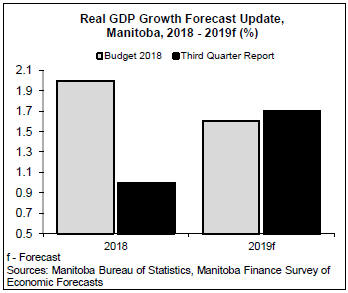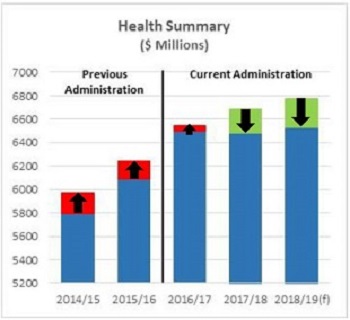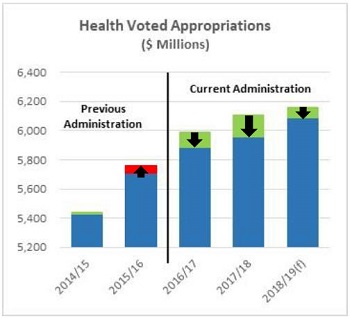ECONOMIC REVIEW AND OUTLOOK
Overview
Manitoba’s economy grew by 1.0% in 2018, slower than the exceptional 3.2% increase in 2017 and below the 2.0% growth projected at the time of Budget 2018.
Nominal GDP, the broadest measure of the tax base, increased by 2.3% in 2018, down from the robust 5.3% increase in 2017.
According to the latest Manitoba Finance Survey of Economic Forecasts, real GDP growth in Manitoba is expected to increase by 1.7% in 2019, up 0.1% from Budget 2018. Nominal GDP growth is expected to increase by 3.6% in 2019.
Canada’s economy is moderating, as rising interest rates, high levels of debt and tighter federal housing regulations temper consumer spending. Real GDP growth in Canada slowed to 2.1% in 2018, down from 3.2% in 2017.

Business investment fell short of expectations, as increased uncertainty surrounding the negotiation of the United States-Mexico-Canada Agreement (USMCA) and new U.S. tariffs on Canadian exports increased investment risk.
The downside risks to global growth are increasing. Manitoba benefits greatly from international and interprovincial trade but challenges exist. In the latest forecasts for global growth, the International Monetary Fund (IMF), Bank of Canada and the Organization
for Economic Co-operation and Development have all lowered their outlook for 2019 as trade barriers rise, monetary policy tightens and geopolitical tensions simmer.
The IMF revised down both its global growth estimate for 2018 and the forecast for 2019 by 0.2% to 3.7% for both estimates, respectively.
Manitoba Economic Performance
In this Economic Review and Outlook report, annual, quarterly, and monthly economic statistics are on a calendar year basis. These statistics are often revised and can change the assessment of economic performance over time.
The Consumer Price Index (CPI) increased by 2.6% in 2018, up from 1.6% in 2017, and above the national increase of 2.3%. Transportation, alcohol and tobacco, and shelter boosted overall consumer prices, while household operations, food and clothing and footwear eased pressure on prices.
In 2018, Manitoba’s employment increased by 3,600, up 0.6% relative to 2017. Part-time employment accounted for almost all the jobs growth in Manitoba, increasing by 3,000. Private sector self-employment rose by 5.0%, second highest among provinces. The unemployment rate averaged 6.0%, up from 5.4% in 2017 and just above the national rate of 5.8%.
Industrial wage growth in Manitoba has strengthened. On a year-to-date basis, average weekly earnings are up to 3.0% in 2018, compared to 2.5% in 2017. This is the highest increase since 2014. The growth is broad based among industries with the service sector leading with a 3.1% increase.
Manitoba retail sales were up 0.3% in the first eleven months of 2018. Retail sales were supported by growth at gasoline stations (12.0%), electronics and appliance stores (10.0%), clothing stores (5.7%), building materials (4.6%) and food and beverage stores (1.1%). Sales were tempered by declines in motor vehicles and parts, furniture and home furnishings stores, health and



